Sites: news | india | latam | brasil | indonesia
Feeds: news | india | latam | brasil | indonesia
topic: Spiders
Social media activity version | Lean version
Study reveals surge in illegal arachnid trade via Facebook in Philippines
- New research by wildlife trade watchdog TRAFFIC reveals a thriving online trade in live tarantulas and scorpions in the Philippines, with more than 16,000 arachnids found offered for sale on Facebook in 2020 and 2022.
- Most traded species are nonnative, but native and threatened tarantulas are also being poached and sold, often before being scientifically described, raising red flags for conservationists.
- The study highlights legal and enforcement gaps, with many sellers likely operating without required permits and rare species potentially being smuggled through postal services.
- Researchers urge stronger regulation of online platforms and closer collaboration with courier services and authorities to curb the illicit trade and protect vulnerable arachnid species.
A venomous Australian spider turns out to be 3 species, not 1
 The Sydney funnel-web spider, a highly venomous arachnid found crawling in and around Australia’s most populous city, was long thought to be a single species. But it’s actually three different species, a new study has found. One of these, called “Big Boy” for its unusually large size, is new to science. “You would think we […]
The Sydney funnel-web spider, a highly venomous arachnid found crawling in and around Australia’s most populous city, was long thought to be a single species. But it’s actually three different species, a new study has found. One of these, called “Big Boy” for its unusually large size, is new to science. “You would think we […]
That ‘killer’ spider story you read online? Fake news, most probably
- Media coverage of human encounters with spiders is rife with misinformation, according to a study by more than 60 scientists around the world.
- They compiled a database of more than 5,300 news articles from 81 countries about these encounters, and found 47% had factual errors and 43% were sensationalistic.
- They also found stories that quoted spider experts tended to be more accurate than those that quoted medical experts of pest control specialists, who don’t receive the same level of training.
- Negative media portrayals of spiders, snakes and other animals that many people tend to dislike hurt efforts to conserve species that play an important role in the ecosystem, the study authors say.
In untangling a taxonomic web, Sri Lankan researchers describe seven new jumping spiders
- A new genetic analysis of the jumping spider genus Flacillula has purged unrelated species and described seven new ones, all endemic to Sri Lanka.
- The genus had been little studied since the type species, F. lubrica, or the oriental jumping spider, was described in 1901.
- Now, it’s joined by seven other species that have been named in honor of historical figures and places where the spiders occur.
- The discovery brings to 159 the number of jumping spiders (family Salticidae) found in Sri Lanka, and puts the island’s total number of spider species at 626.
Here goes nothing: Male spiders found giving females silk-wrapped zilch
- Researchers describe how a South American spider species, Paradossenus longipes, uses silk-wrapped nuptial gifts in its courtship rituals.
- While other gift-wrapping spiders give potential mates edible prey or inedible leftovers, P. longipes surprised scientists by sometimes presenting females with empty gifts.
- The discovery of empty nuptial gifts in spiders raises questions about how the behavior evolved and the role it plays in sexual selection and mating success.
Top 15 species discoveries from 2020 (Photos)
- In 2020, Mongabay and others reported on several announcements of species new to science.
- Snakes, insects, many new orchids, frogs, and even a few mammals were named in 2020.
- In no particular order, we present our 15 top picks.
The world’s a stage for these four new jumping spiders from Sri Lanka
- Sri Lanka has yielded up four new species of Asian jumping spiders, the first time spiders from the genus Synagelides have been recorded on the biodiversity-rich Indian Ocean island.
- The new species, cryptic small spiders that live in association with ants, have been named Synagelides hortonensis, S. lakmalii, S. rosalindae and S. orlandoi.
- The latter two are named after Rosalind Senior and Orlando de Bois, a pair of lovers in the Shakespeare comedy “As You Like It”; S. hortonensis is named after Horton Plains National Park, from where the type specimen was described; and S. lakmalii after scientist U.G. Sasanka Lakmali Ranasinghe.
Sex organs reveal new jumping spider species in the Philippines
- A father-and-daughter pair of Philippine scientists have described three new species of jumping spiders in the country after carefully examining the arachnids’ reproductive organs.
- The new spiders belong to the genus Lepidemathis that’s only found in the Philippines; the new arrivals raise the number of Lepidemathis species from four to seven.
- The spiders were found in three separate provinces on the main island of Luzon in 2014; arachnologist Aimee Lynn Barrion-Dupo and her father, entomologist Albert Barrion, spent the following years trying to differentiate the species from other jumping spiders.
- Male jumping spiders are known for their well-choreographed courtship dance, and it’s possible these new species have a unique song and dance number too, the researchers say.
Predators disproportionately impacted by human land use changes, study finds
- New research looking at whether particular types of wildlife are more affected than others by habitat loss determined that predators are the most impacted, as was expected — but the study results held some surprises nonetheless.
- Because the loss of plant resources makes it harder for large predators to find sufficient food when land use changes occur within their range, researchers expected to find that these types of animals would be especially affected.
- The analysis showed that predators are indeed more affected by habitat loss than other groups — but that larger carnivores are not threatened with the largest declines. It was small invertebrates that were found to face the worst impacts.
New parasitoid wasp species discovered in Amazon manipulate host behavior in ‘complex way’
- Researchers have discovered 15 new wasp species in lowland Amazon rainforests and Andean cloud forests that parasitize spiders in a “complex way.”
- Female Acrotaphus wasps are known to attack spiders in their webs, temporarily paralyzing the arachnids with a venomous sting so they can lay a single egg on a spider. The wasp larva then hatches from the egg and gradually eats the spider before it pupates.
- According to study co-author Ilari E. Sääksjärvi, a professor of biodiversity research at the University of Turku, the 15 newly discovered species of Acrotaphus wasps control host spiders’ behavior in very particular ways in order to ensure the survival of their offspring.
Stylish jumping spider named after late fashion icon Karl Lagerfeld
- Researchers have named a previously undescribed species of black-and-white jumping spider Jotus karllagerfeldi, after the late fashion icon Karl Lagerfeld, known for his signature black-and-white style.
- In addition to Karl Lagerfeld’s jumping spider, researchers have described four more new-to-science species of jumping spiders in the new paper, including J. albimanus, J. fortiniae, J. moonensis and J. newtoni.
- All five newly described species belong to a group of miniscule spiders called the brushed jumping spiders, males of which can be extremely colorful and are known to perform elaborate mating dances using a brush of long, colorful bristles on their legs to wave to the females.
- Despite being colorful and charismatic, very little is known about brushed jumping spiders, researchers say, urging amateurs who photograph these spiders to lodge their specimens with museums so that more new species can be described.
Mongabay investigative series helps confirm global insect decline
- In a newly published four-part series, Mongabay takes a deep dive into the science behind the so-called “Insect Apocalypse,” recently reported in the mainstream media.
- To create the series, Mongabay interviewed 24 entomologists and other scientists on six continents and working in 12 nations, producing what is possibly the most in-depth reporting published to date by any news media outlet on the looming insect abundance crisis.
- While major peer-reviewed studies are few (with evidence resting primarily so far on findings in Germany and Puerto Rico), there is near consensus among the two dozen researchers surveyed: Insects are likely in serious global decline.
- The series is in four parts: an introduction and critical review of existing peer-reviewed data; a look at temperate insect declines; a survey of tropical declines; and solutions to the problem. Researchers agree: Conserving insects — imperative to preserving the world’s ecosystem services — is vital to humanity.
The Great Insect Dying: How to save insects and ourselves
- The entomologists interviewed for this Mongabay series agreed on three major causes for the ongoing and escalating collapse of global insect populations: habitat loss (especially due to agribusiness expansion), climate change and pesticide use. Some added a fourth cause: human overpopulation.
- Solutions to these problems exist, most agreed, but political commitment, major institutional funding and a large-scale vision are lacking. To combat habitat loss, researchers urge preservation of biodiversity hotspots such as primary rainforest, regeneration of damaged ecosystems, and nature-friendly agriculture.
- Combatting climate change, scientists agree, requires deep carbon emission cuts along with the establishment of secure, very large conserved areas and corridors encompassing a wide variety of temperate and tropical ecosystems, sometimes designed with preserving specific insect populations in mind.
- Pesticide use solutions include bans of some toxins and pesticide seed coatings, the education of farmers by scientists rather than by pesticide companies, and importantly, a rethinking of agribusiness practices. The Netherlands’ Delta Plan for Biodiversity Recovery includes some of these elements.
The Great Insect Dying: The tropics in trouble and some hope
- Insect species are most diverse in the tropics, but are largely unresearched, with many species not described by science. But entomologists believe abundance is being impacted by climate change, habitat destruction and the introduction of industrial agribusiness with its heavy pesticide use.
- A 2018 repeat of a 1976 study in Puerto Rico, which measured the total biomass of a rainforest’s arthropods, found that in the intervening decades populations collapsed. Sticky traps caught up to 60-fold fewer insects than 37 years prior, while ground netting caught 8 times fewer insects than in 1976.
- The same researchers also looked at insect abundance in a tropical forest in Western Mexico. There, biomass abundance fell eightfold in sticky traps from 1981 to 2014. Researchers from Southeast Asia, Australia, Oceania and Africa all expressed concern to Mongabay over possible insect abundance declines.
- In response to feared tropical declines, new insect surveys are being launched, including the Arthropod Initiative and Global Malaise Trap Program. But all of these new initiatives suffer the same dire problem: a dearth of funding and lack of interest from foundations, conservation groups and governments.
The Great Insect Dying: Vanishing act in Europe and North America
- Though arthropods make up most of the species on Earth, and much of the planet’s biomass, they are significantly understudied compared to mammals, plants, birds, amphibians, reptiles and fish. Lack of baseline data makes insect abundance decline difficult to assess.
- Insects in the temperate EU and U.S. are the world’s best studied, so it is here that scientists expect to detect precipitous declines first. A groundbreaking study published in October 2017 found that flying insects in 63 protected areas in Germany had declined by 75 percent in just 25 years.
- The UK Butterfly Monitoring Scheme has a 43-year butterfly record, and over that time two-thirds of the nations’ species have decreased. Another recent paper found an 84 percent decline in butterflies in the Netherlands from 1890 to 2017. Still, EU researchers say far more data points are needed.
- Neither the U.S. or Canada have conducted an in-depth study similar to that in Germany. But entomologists agree that major abundance declines are likely underway, and many are planning studies to detect population drops. Contributors to decline are climate change, pesticides and ecosystem destruction.
The Great Insect Dying: A global look at a deepening crisis
- Recent studies from Germany and Puerto Rico, and a global meta-study, all point to a serious, dramatic decline in insect abundance. Plummeting insect populations could deeply impact ecosystems and human civilization, as these tiny creatures form the base of the food chain, pollinate, dispose of waste, and enliven soils.
- However, limited baseline data makes it difficult for scientists to say with certainty just how deep the crisis may be, though anecdotal evidence is strong. To that end, Mongabay is launching a four-part series — likely the most in-depth, nuanced look at insect decline yet published by any media outlet.
- Mongabay interviewed 24 entomologists and researchers on six continents working in over a dozen nations to determine what we know regarding the “great insect dying,” including an overview article, and an in-depth story looking at temperate insects in the U.S. and the European Union — the best studied for their abundance.
- We also utilize Mongabay’s position as a leader in tropical reporting to focus solely on insect declines in the tropics and subtropics, where lack of baseline data is causing scientists to rush to create new, urgently needed survey study projects. The final story looks at what we can do to curb and reverse the loss of insect abundance.
Video: scientists capture giant spider eating an opossum
- For the first time, researchers have documented a giant spider eating an opossum in the Amazon rainforest.
- Writing in the February 28th issue of the journal Amphibian & Reptile Conservation, a team of scientists describe several rarely observed cases of invertebrates eating various vertebrates, including frogs, lizards, snakes, and even a mammal — a mouse opossum.
- The mouse opossum incident occurred in 2016 in the Peruvian Amazon and was captured on film by biology students.
- The sighting was the first of a mygalomorph spider — a group of large spiders that includes tarantulas — preying on an opossum.
Photos: Here are the winners of the 2018 British Ecological Society photo contest
- Chris Oosthuizen of South Africa’s University of Pretoria won the top prize in the British Ecological Society’s “Capturing Ecology” photo competition this year with an image of a single colorful adult king penguin amidst a crowd of brown-colored chicks on Marion Island, part of the Prince Edward Islands in the Indian Ocean.
- Oosthuizen is hopeful that the prize-winning photo might help draw attention to the challenges king penguins face due to the impacts of human activities. “Although the global population of king penguins is large, populations inhabiting islands around the Antarctic face an uncertain future,” he said.
- In total, some 16 images were recognized this year by the British Ecological Society. “Capturing flora and fauna from across the planet, subjects range from African wild dog research to an artistic take on Galapagos iguanas to images exploring the relationships between people and nature,” the group said in a statement.
Online citizen science data platforms help scientists predict species ranges
- Researchers paired museum collection information for two species of spiders, dating back several decades, with more recent information from online citizen science databases and compared them to climate data to find areas with conditions suitable for each species.
- They developed maps of predicted geographic distributions for each species and, despite limited data, their findings suggest ranges of both species have shifted northward over time.
- The researchers highlight the importance of citizen science data in generating long-term data sets on species distributions.
A warmer climate tinkers with Arctic spider’s choice of prey
- A team of researchers found that higher temperatures led Arctic wolf spiders to eat fewer insect-like springtails in study plots.
- Springtails eat fungus, an essential decomposer in the Arctic ecosystem, so with more springtails around in the warmer study plots, there was less decomposition.
- The scientists suggest that this change in prey preference could modulate the effects of a warming climate on the carbon that’s released from the thawing tundra.
New ‘goblin spiders’ from Sri Lanka named after Enid Blyton characters
- Scientists have discovered nine new species of “goblin spiders” in Sri Lanka, of which they’ve named six after popular goblin characters from Enid Blyton’s children’s books.
- Two of the nine newly described species belong to genera (Cavisternum and Grymeus) that have never been recorded outside of Australia before.
- Most of the newly described goblin spider species seem to occur only in a few sites, or just a single forest patch, and may all be critically endangered, the authors of the study think.
Webs under water: The really bizarre lives of intertidal spiders
- Scientists have discovered a 15th species of intertidal spider, a family of unusual arachnids that live in coastal habitats that are submerged during high tides.
- The newest species, named after singer Bob Marley, was discovered living on brain coral off the Australian coast.
- Scientists know that some species create air pockets with their hairs, while others build waterproof webs, but little is known about most of these fascinating spiders.
- Intertidal spiders face a number of threats, including rising sea levels due to climate change, and pollution.
Stranger than fiction? New spiders found in Brazil named after creatures from popular fantasy stories
- Seven recently discovered spiders all belong to the genus Ochyrocera and were found in the iron caves of Floresta Nacional de Carajás in the northern Brazilian state of Pará.
- While all seven species can live and breed without sunlight, they’re not necessarily consigned to the deepest depths of the underworld. The same cannot be said for some of the new spiders’ namesakes, however.
- Researchers with the Sao Paulo, Brazil-based Instituto Butantan have named the seven new spiders in honor of characters from fantasy works like The Lord of the Rings and the Harry Potter series.
Photos: Top 20 new species of 2017
- There’s still so much we don’t know about life on planet Earth that scientists discover new species with whom we share this planet nearly every day.
- For instance, this year scientists described a new species of orangutan in Sumatra — just the eighth great ape species known to exist on planet Earth. And that’s just one of many notable, bizarre, or downright fascinating discoveries made this year.
- Here, in no particular order, we present the top 20 new species discovered in 2017.
Meet the new Bernie Sanders spider
- Together with four of his undergraduate students, Ingi Agnarsson, a spider expert and professor of biology at the University of Vermont, described 15 new spiders in a paper published by the Zoological Journal of the Linnean Society this week.
- All 15 of the new species belong to the genus Spintharus and are known as “smiley-faced” spiders because of the patterning on their abdomens that resemble a smiley face.
- Each of Agnarsson’s graduate students, who did the photography and lab work to document the new species, were given the chance to name a few of the spiders. “[B]ut we all named the Bernie Sanders spider,” Lily Sargeant, one of the students and a co-author of the paper, said in a statement. “We all have tremendous respect for Bernie. He presents a feeling of hope.”
Australian spider named for world champion surfer
- Pisauridae mickfanningi is a newly discovered species of water spider named in the surfer’s honor.
- The Queensland Museum actually let the public name the new species as part of the World Science Festival Brisbane, which took place in late March. The public was asked to submit names inspired by the science festival and its setting in Queensland.
- Brazilian arachnologist and surfing fan Hector Manuel Osório Gonzalez Filho submitted the name mickfanningi for the new water spider as a tribute to Fanning, whose favorite surfing spot is said to be Snapper Rocks in Queensland.
50 new spiders discovered in Australia
- The two-week expedition in Australia’s Cape York Peninsula involved 23 scientists, indigenous rangers and traditional owners.
- This expedition will likely result in the greatest number of new species of spiders discovered on a Bush Blitz research trip, scientists say.
- The researchers are now identifying and describing the spiders for formal scientific classification.
Newscast #8: Top new species discoveries of 2016, and how fig trees can save rainforests
- The new species we discover every year prove that we still aren’t even aware of every creature with whom we share planet Earth, so there’s literally more to protect than we can possibly know.
- We also speak with author Mike Shanahan, whose new book 'Gods, Wasps, and Stranglers: The secret history and redemptive future of fig trees' looks at the tropical species’ biology and key ecological role, as well as its deep cultural (and spiritual) place in human history.
- Thanks to everyone who made the launch of the Mongabay Newscast in 2016 such a success!
This new spider looks like the sorting hat from Harry Potter
- The spider was collected from a small sacred grove — patches of forests preserved ancestrally by local communities — in Shivamogga district in the southern state of Karnataka, India.
- As fans of the Harry Potter franchise, the researchers chose to name the spider Eriovixia gryffindori after the magical sorting hat, owned by Godric Gryffindor.
- The tiny spider is an excellent mimic, and is adept at resembling dried foliage.
Scientists have discovered six new dancing peacock spiders in Australia
- One of the colorful new spiders, Maratus lincunxin, was named after Chinese-trained dancer and Queensland Ballet artistic director Li Cunxin.
- Queensland Museum scientist Dr Barbara Baehr discovered Maratus lincunxin at Carnarvon Station in western Queensland and decided to name the species in honor of Li Cunxin after a visit to the ballet with her daughter.
- Besides their dance moves, peacock spiders, which are jumping spiders endemic to Australia, are known for their colorful abdomens — Maratus lincunxin’s, for instance, is bright blue.
New tarantula named after Nobel Laureate Gabriel García Márquez
- Scientists discovered Kankuamo marquezi in the Sierra Nevada de Santa Maria mountain range in Colombia.
- The new tarantula has a unique way of subduing its enemies — it stabs its butt’s bristled hairs into the enemy directly instead of releasing a flying cloud of sharp hairs into the air as many other tarantulas do.
- The scientists have named the spider’s genus Kankuamo, which refers to a group of indigenous people of the Chibcha family from the Caribbean region of Colombia that live on the eastern slope of the Sierra Nevada de Santa Marta.
7 new brilliantly-colored peacock spiders discovered
- The seven newly described spiders have striking patterns on their backs.
- One spider, Maratus vespa, has a distinct pattern on its tail flap that resembles the outline of a wasp.
- Another spider, Maratus bubo, seems to have the face of a horned owl inscribed on its back.
Australia announces a new spider species called ‘Brian’
- Dolomedes briangreenei, nicknamed “Brian,” is a newly described species of water spider that lives in Queensland.
- The spider was named after U.S. physicist Brian Greene, and finds prey by sensing vibrational waves.
- The spiders eat fish, frogs, and tadpoles – including those of the highly invasive and ecologically destructive cane toad.
Meet the new spider named after Johnny Cash
- According to the results of a decade-long study by biologists at Auburn University and Millsaps College, there are not, in fact, fifty or so different species of tarantulas in the US, as scientists previously believed.
- After studying nearly 3,000 specimens, the researchers found there are just 29 species in the US — 14 of which are entirely new to science.
- Aphonopelma johnnycashi males are generally solid black in coloration, which made them an even more fitting homage to Cash, who was known as “the Man in Black.”
To collect or not to collect? Experts debate the need for specimens
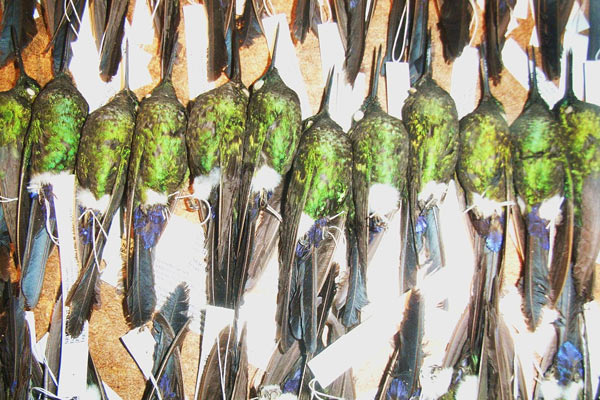 Modern day expeditions face a collection dilemma as scientists consider ethics and endangerment A tray of Eriocnemis (a genus of hummingbird) specimens, Swedish Museum of Natural History – Naturhistoriska Riksmuseet,Stockholm, CC BY-SA 3,0 License, Wikimedia. In 1912, a group of intrepid explorers led by Rollo and Ida Beck, widely acknowledged to be the foremost marine […]
Modern day expeditions face a collection dilemma as scientists consider ethics and endangerment A tray of Eriocnemis (a genus of hummingbird) specimens, Swedish Museum of Natural History – Naturhistoriska Riksmuseet,Stockholm, CC BY-SA 3,0 License, Wikimedia. In 1912, a group of intrepid explorers led by Rollo and Ida Beck, widely acknowledged to be the foremost marine […]
The enemy of your enemy is your ant bodyguard: spider uses one predator for protection against another
 The notion of spiders using ants as bodyguards seems a bit contradictory, but that is exactly what occurs on the tropical forest floors of the Philippines. The jumping spider (Phintella piatensis) strategically nests within the vicinity of the aggressive Asian weaver ant (Ocecophylla smaragdina) as a defense tactic against its main predator, the spitting spider […]
The notion of spiders using ants as bodyguards seems a bit contradictory, but that is exactly what occurs on the tropical forest floors of the Philippines. The jumping spider (Phintella piatensis) strategically nests within the vicinity of the aggressive Asian weaver ant (Ocecophylla smaragdina) as a defense tactic against its main predator, the spitting spider […]
Rare animal species and Buddhist monks in danger of losing their home to cement quarry
 An international cement company Lafarge, winner of a Green Initiative award, is considering quarrying a cave in Malaysia which is the sole home of a critically endangered species. The proposed operations also threaten a Buddhist monastery near the cave where monks are facing eviction. Kanthan cave in Peninsular Malaysia is located in a limestone hill, […]
An international cement company Lafarge, winner of a Green Initiative award, is considering quarrying a cave in Malaysia which is the sole home of a critically endangered species. The proposed operations also threaten a Buddhist monastery near the cave where monks are facing eviction. Kanthan cave in Peninsular Malaysia is located in a limestone hill, […]
Scientists discover two mini-spiders in China (photos)
 Scientists have uncovered two miniature spiders living on mountains in China’s southern region, one of which is among the smallest spiders recorded worldwide, according to a new paper in ZooKeys. Both spiders belong to the Mysmenidae family, which is made up of mini-spiders with eight eyes. “Although the family Mysmenidae is distributed worldwide, it is […]
Scientists have uncovered two miniature spiders living on mountains in China’s southern region, one of which is among the smallest spiders recorded worldwide, according to a new paper in ZooKeys. Both spiders belong to the Mysmenidae family, which is made up of mini-spiders with eight eyes. “Although the family Mysmenidae is distributed worldwide, it is […]
New giant tarantula that’s taken media by storm likely Critically Endangered (photos)
 Described by a number of media outlets as “the size of your face” a new tree-dwelling tarantula discovered in Sri Lanka has awed arachnophiliacs and terrified arachnophobes alike. But the new species, named Raja’s tiger spider (Poecilotheria rajaei), is likely Critically Endangered according to the scientist that discovered it in northern Sri Lanka. “I would […]
Described by a number of media outlets as “the size of your face” a new tree-dwelling tarantula discovered in Sri Lanka has awed arachnophiliacs and terrified arachnophobes alike. But the new species, named Raja’s tiger spider (Poecilotheria rajaei), is likely Critically Endangered according to the scientist that discovered it in northern Sri Lanka. “I would […]
Happy Halloween: nine new species of tree-climbing tarantula discovered
 Male specimen of new species: Iridopelma oliveirai. Photo courtesy of R. Bertani. If you suffer from acute arachnophobia, this is the perfect Halloween discovery for you: a spider expert has discovered nine new species of arboreal (tree-dwelling) tarantulas in the Brazil. Although tarantula diversity is highest in the Amazon rainforest, the new species are all […]
Male specimen of new species: Iridopelma oliveirai. Photo courtesy of R. Bertani. If you suffer from acute arachnophobia, this is the perfect Halloween discovery for you: a spider expert has discovered nine new species of arboreal (tree-dwelling) tarantulas in the Brazil. Although tarantula diversity is highest in the Amazon rainforest, the new species are all […]
Arachnopocalypse: with birds away, the spiders play in Guam
 The accidental introduction of the brown tree snake on Guam has resulted in a loss of birds and a subsequent explosion of spiders. Photo by: Isaac Chellman. The island of Guam is drowning in spiders. New research in the open-access journal PLOS ONE has found that in the wet season, Guam’s arachnid population booms to […]
The accidental introduction of the brown tree snake on Guam has resulted in a loss of birds and a subsequent explosion of spiders. Photo by: Isaac Chellman. The island of Guam is drowning in spiders. New research in the open-access journal PLOS ONE has found that in the wet season, Guam’s arachnid population booms to […]
Velociraptor spider discovered in Oregon cave (pictures)
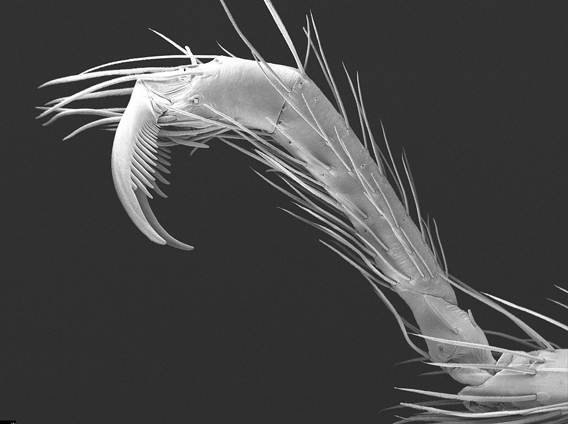 Close-up of the remarkable, raptor-like claws of Trogloraptor. Photo by: Griswold CE, Audisio T, Ledford JM. Scouring the caves of Southwest Oregon, scientists have made the incredible discovery of a fearsome apex predator with massive, sickle claws. No, it’s not the Velociraptor from Jurassic Park: it’s a large spider that is so unique scientists were […]
Close-up of the remarkable, raptor-like claws of Trogloraptor. Photo by: Griswold CE, Audisio T, Ledford JM. Scouring the caves of Southwest Oregon, scientists have made the incredible discovery of a fearsome apex predator with massive, sickle claws. No, it’s not the Velociraptor from Jurassic Park: it’s a large spider that is so unique scientists were […]
Blue tarantula, walking cactus, and a worm from Hell: the top 10 new species of 2011
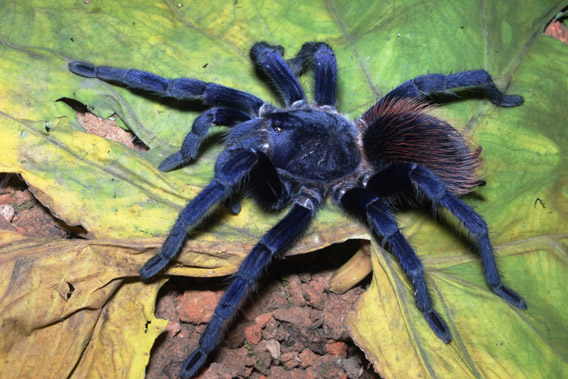 Sazima’s tarantula: one of the top ten new species discovered in 2011 according to the annual list by the International Institute for Species Exploration at Arizona State University. Photo by: Caroline S. Fukushima. A sneezing monkey, a blue tarantula, and an extinct walking cactus are just three of the remarkable new species listed in the […]
Sazima’s tarantula: one of the top ten new species discovered in 2011 according to the annual list by the International Institute for Species Exploration at Arizona State University. Photo by: Caroline S. Fukushima. A sneezing monkey, a blue tarantula, and an extinct walking cactus are just three of the remarkable new species listed in the […]
Photos: Halloween creepy-crawlies of the natural world
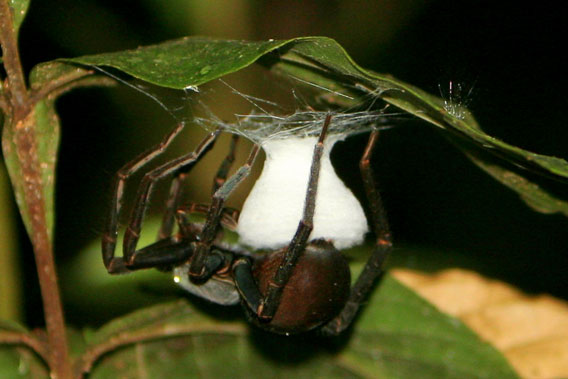 Everyone loves the beautiful animals, the playful orangutans, the rolly-polly pandas, the regal tigers, the wise elephants, the awe-inspiring whales, the silly penguins—and it shows. Aside from gracing calendars and starring in movies, these species receive millions in conservation funds and have no shortage of researchers devoted to them. But what about the ugly, crawly, […]
Everyone loves the beautiful animals, the playful orangutans, the rolly-polly pandas, the regal tigers, the wise elephants, the awe-inspiring whales, the silly penguins—and it shows. Aside from gracing calendars and starring in movies, these species receive millions in conservation funds and have no shortage of researchers devoted to them. But what about the ugly, crawly, […]
Photos: the top ten new species discovered in 2010
- If we had to characterize our understanding of life on Earth as either ignorant or knowledgeable, the former would be most correct.
- In 250 years of rigorous taxonomic work researchers have cataloged nearly two million species, however scientists estimate the total number of species on Earth is at least five million and perhaps up to a hundred million.
- This means every year thousands of new species are discovered by researchers, and from these thousands, the International Institute for Species Exploration at Arizona State University selects ten especially notable new species.
Undercover for animals: on the frontline of wildlife crime in the US
 US Fish and Wildlife Service Special Agent Sheila O’Connor revealed the inside story of working in wildlife law enforcement to Laurel Neme on her “The WildLife” radio show and podcast. In the first of a two-part interview, Special Agent O’Connor talks about her adventures stopping wildlife crime—scoping out pet shops in the Chicago area for […]
US Fish and Wildlife Service Special Agent Sheila O’Connor revealed the inside story of working in wildlife law enforcement to Laurel Neme on her “The WildLife” radio show and podcast. In the first of a two-part interview, Special Agent O’Connor talks about her adventures stopping wildlife crime—scoping out pet shops in the Chicago area for […]
Life shocker: new species discovered every three days in the Amazon
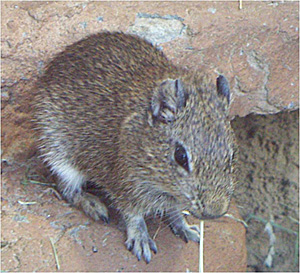 A look back at species discovered over the last decade in the Amazon. A new report by the World Wide Fund for Nature (WWF) confirms the Amazon rainforest, even as it is shrinking due to deforestation, remains among the world’s most surprising places. According to the report, Amazon Alive, over the past decade (1999-2009) researchers […]
A look back at species discovered over the last decade in the Amazon. A new report by the World Wide Fund for Nature (WWF) confirms the Amazon rainforest, even as it is shrinking due to deforestation, remains among the world’s most surprising places. According to the report, Amazon Alive, over the past decade (1999-2009) researchers […]
Photos: 200 new species discovered in 60-day expedition in New Guinea
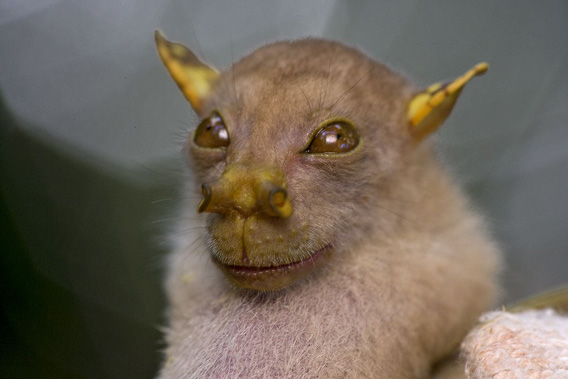 This fruit bat has been seen prior to this expedition, but remains undescribed. Although scientists have yet to name the species, the popular media has already dubbed it the ‘Yoda bat’ given its resemblance to the Jedi master character from the Star Wars series. Fruit bats are vital to rainforests as they disperse seeds. Photo […]
This fruit bat has been seen prior to this expedition, but remains undescribed. Although scientists have yet to name the species, the popular media has already dubbed it the ‘Yoda bat’ given its resemblance to the Jedi master character from the Star Wars series. Fruit bats are vital to rainforests as they disperse seeds. Photo […]
Feeds: news | india | latam | brasil | indonesia
 The Sydney funnel-web spider, a highly venomous arachnid found crawling in and around Australia’s most populous city, was long thought to be a single species. But it’s actually three different species, a new study has found. One of these, called “Big Boy” for its unusually large size, is new to science. “You would think we […]
The Sydney funnel-web spider, a highly venomous arachnid found crawling in and around Australia’s most populous city, was long thought to be a single species. But it’s actually three different species, a new study has found. One of these, called “Big Boy” for its unusually large size, is new to science. “You would think we […] Modern day expeditions face a collection dilemma as scientists consider ethics and endangerment A tray of Eriocnemis (a genus of hummingbird) specimens, Swedish Museum of Natural History – Naturhistoriska Riksmuseet,Stockholm, CC BY-SA 3,0 License, Wikimedia. In 1912, a group of intrepid explorers led by Rollo and Ida Beck, widely acknowledged to be the foremost marine […]
Modern day expeditions face a collection dilemma as scientists consider ethics and endangerment A tray of Eriocnemis (a genus of hummingbird) specimens, Swedish Museum of Natural History – Naturhistoriska Riksmuseet,Stockholm, CC BY-SA 3,0 License, Wikimedia. In 1912, a group of intrepid explorers led by Rollo and Ida Beck, widely acknowledged to be the foremost marine […] The notion of spiders using ants as bodyguards seems a bit contradictory, but that is exactly what occurs on the tropical forest floors of the Philippines. The jumping spider (Phintella piatensis) strategically nests within the vicinity of the aggressive Asian weaver ant (Ocecophylla smaragdina) as a defense tactic against its main predator, the spitting spider […]
The notion of spiders using ants as bodyguards seems a bit contradictory, but that is exactly what occurs on the tropical forest floors of the Philippines. The jumping spider (Phintella piatensis) strategically nests within the vicinity of the aggressive Asian weaver ant (Ocecophylla smaragdina) as a defense tactic against its main predator, the spitting spider […] An international cement company Lafarge, winner of a Green Initiative award, is considering quarrying a cave in Malaysia which is the sole home of a critically endangered species. The proposed operations also threaten a Buddhist monastery near the cave where monks are facing eviction. Kanthan cave in Peninsular Malaysia is located in a limestone hill, […]
An international cement company Lafarge, winner of a Green Initiative award, is considering quarrying a cave in Malaysia which is the sole home of a critically endangered species. The proposed operations also threaten a Buddhist monastery near the cave where monks are facing eviction. Kanthan cave in Peninsular Malaysia is located in a limestone hill, […] Scientists have uncovered two miniature spiders living on mountains in China’s southern region, one of which is among the smallest spiders recorded worldwide, according to a new paper in ZooKeys. Both spiders belong to the Mysmenidae family, which is made up of mini-spiders with eight eyes. “Although the family Mysmenidae is distributed worldwide, it is […]
Scientists have uncovered two miniature spiders living on mountains in China’s southern region, one of which is among the smallest spiders recorded worldwide, according to a new paper in ZooKeys. Both spiders belong to the Mysmenidae family, which is made up of mini-spiders with eight eyes. “Although the family Mysmenidae is distributed worldwide, it is […] Described by a number of media outlets as “the size of your face” a new tree-dwelling tarantula discovered in Sri Lanka has awed arachnophiliacs and terrified arachnophobes alike. But the new species, named Raja’s tiger spider (Poecilotheria rajaei), is likely Critically Endangered according to the scientist that discovered it in northern Sri Lanka. “I would […]
Described by a number of media outlets as “the size of your face” a new tree-dwelling tarantula discovered in Sri Lanka has awed arachnophiliacs and terrified arachnophobes alike. But the new species, named Raja’s tiger spider (Poecilotheria rajaei), is likely Critically Endangered according to the scientist that discovered it in northern Sri Lanka. “I would […] Male specimen of new species: Iridopelma oliveirai. Photo courtesy of R. Bertani. If you suffer from acute arachnophobia, this is the perfect Halloween discovery for you: a spider expert has discovered nine new species of arboreal (tree-dwelling) tarantulas in the Brazil. Although tarantula diversity is highest in the Amazon rainforest, the new species are all […]
Male specimen of new species: Iridopelma oliveirai. Photo courtesy of R. Bertani. If you suffer from acute arachnophobia, this is the perfect Halloween discovery for you: a spider expert has discovered nine new species of arboreal (tree-dwelling) tarantulas in the Brazil. Although tarantula diversity is highest in the Amazon rainforest, the new species are all […] The accidental introduction of the brown tree snake on Guam has resulted in a loss of birds and a subsequent explosion of spiders. Photo by: Isaac Chellman. The island of Guam is drowning in spiders. New research in the open-access journal PLOS ONE has found that in the wet season, Guam’s arachnid population booms to […]
The accidental introduction of the brown tree snake on Guam has resulted in a loss of birds and a subsequent explosion of spiders. Photo by: Isaac Chellman. The island of Guam is drowning in spiders. New research in the open-access journal PLOS ONE has found that in the wet season, Guam’s arachnid population booms to […] Close-up of the remarkable, raptor-like claws of Trogloraptor. Photo by: Griswold CE, Audisio T, Ledford JM. Scouring the caves of Southwest Oregon, scientists have made the incredible discovery of a fearsome apex predator with massive, sickle claws. No, it’s not the Velociraptor from Jurassic Park: it’s a large spider that is so unique scientists were […]
Close-up of the remarkable, raptor-like claws of Trogloraptor. Photo by: Griswold CE, Audisio T, Ledford JM. Scouring the caves of Southwest Oregon, scientists have made the incredible discovery of a fearsome apex predator with massive, sickle claws. No, it’s not the Velociraptor from Jurassic Park: it’s a large spider that is so unique scientists were […] Sazima’s tarantula: one of the top ten new species discovered in 2011 according to the annual list by the International Institute for Species Exploration at Arizona State University. Photo by: Caroline S. Fukushima. A sneezing monkey, a blue tarantula, and an extinct walking cactus are just three of the remarkable new species listed in the […]
Sazima’s tarantula: one of the top ten new species discovered in 2011 according to the annual list by the International Institute for Species Exploration at Arizona State University. Photo by: Caroline S. Fukushima. A sneezing monkey, a blue tarantula, and an extinct walking cactus are just three of the remarkable new species listed in the […] Everyone loves the beautiful animals, the playful orangutans, the rolly-polly pandas, the regal tigers, the wise elephants, the awe-inspiring whales, the silly penguins—and it shows. Aside from gracing calendars and starring in movies, these species receive millions in conservation funds and have no shortage of researchers devoted to them. But what about the ugly, crawly, […]
Everyone loves the beautiful animals, the playful orangutans, the rolly-polly pandas, the regal tigers, the wise elephants, the awe-inspiring whales, the silly penguins—and it shows. Aside from gracing calendars and starring in movies, these species receive millions in conservation funds and have no shortage of researchers devoted to them. But what about the ugly, crawly, […] US Fish and Wildlife Service Special Agent Sheila O’Connor revealed the inside story of working in wildlife law enforcement to Laurel Neme on her “The WildLife” radio show and podcast. In the first of a two-part interview, Special Agent O’Connor talks about her adventures stopping wildlife crime—scoping out pet shops in the Chicago area for […]
US Fish and Wildlife Service Special Agent Sheila O’Connor revealed the inside story of working in wildlife law enforcement to Laurel Neme on her “The WildLife” radio show and podcast. In the first of a two-part interview, Special Agent O’Connor talks about her adventures stopping wildlife crime—scoping out pet shops in the Chicago area for […] A look back at species discovered over the last decade in the Amazon. A new report by the World Wide Fund for Nature (WWF) confirms the Amazon rainforest, even as it is shrinking due to deforestation, remains among the world’s most surprising places. According to the report, Amazon Alive, over the past decade (1999-2009) researchers […]
A look back at species discovered over the last decade in the Amazon. A new report by the World Wide Fund for Nature (WWF) confirms the Amazon rainforest, even as it is shrinking due to deforestation, remains among the world’s most surprising places. According to the report, Amazon Alive, over the past decade (1999-2009) researchers […] This fruit bat has been seen prior to this expedition, but remains undescribed. Although scientists have yet to name the species, the popular media has already dubbed it the ‘Yoda bat’ given its resemblance to the Jedi master character from the Star Wars series. Fruit bats are vital to rainforests as they disperse seeds. Photo […]
This fruit bat has been seen prior to this expedition, but remains undescribed. Although scientists have yet to name the species, the popular media has already dubbed it the ‘Yoda bat’ given its resemblance to the Jedi master character from the Star Wars series. Fruit bats are vital to rainforests as they disperse seeds. Photo […]